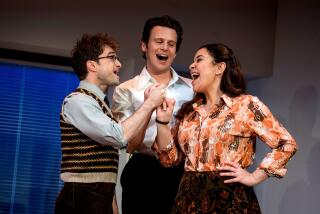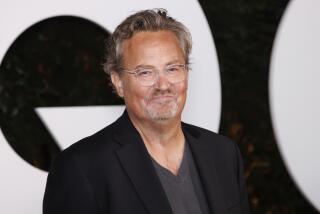‘Friends’ producer Kevin Bright’s very non-Central Perk post-show journey
About a decade ago, the “Friends” executive producer Kevin Bright hit a low point in his life.
That might seem unlikely for somebody coming off one of the most-watched sitcoms in television history (and the financial bounty that arrived with it).
But after 10 seasons of the NBC phenomenon, Bright found himself bereft. He was working 60-hour weeks for years on “Friends,” which he had brought to NBC with Marta Kauffman and David Crane. He was never home for his two young sons. Sleep eluded. He and his wife, Claudia, were separating.
On top of that he had just fought a losing battle — with the network, with writers, with public perception — on the spinoff “Joey,” which he also executive produced, problems compounded because of the hybrid status Bright occupied in Hollywood as a non-writing producer.
Burned out and doubting what it was all for, Bright decided to pick up and move about as far away from Hollywood as one could while remaining in the continental U.S. — to Boston, leaving behind his family and chosen profession. Bright’s plan was to teach some television production classes at his alma mater of Emerson College and… regroup? Detach? He wasn’t sure. But something had to give.
As it turned out, the producer was at the beginning of an unexpected trip. That journey led him to create an intimate heartwarmer of a documentary, “Best and Most Beautiful Things,” now in theaters and due out on iTunes on Tuesday; PBS will air it on Independent Lens Jan. 2.
Yet the film is only the most exposed facet of a much larger redemption story. That tale, with an extra bit of resonance during this holiday moment, includes a turn of cosmic randomness at a Celtics game, a teaching job at a school for the blind and an encounter with a Boston bartender who had served in the first Iraq war.
“I was done. And the last thing I wanted to do was jump on another TV show,” Bright said. “I needed to realign myself.”
On a manic pre-holiday Friday, Bright, 62, sat in a Brentwood cafe. Clad in a hipster T-shirt bearing Matt LeBlanc’s face (emblazoned message: “Joey Division: Unknown Friends”), he evinced both a kind of producer’s toughness and spastic charisma. As he cut into a dessert, the show runner recalled his time in Boston and that unassuming night, nearly nine years before, when he attended a Celtics game.
During a break in the action, a choir from the Perkins School for the Blind gave an on-court performance. It caught Bright’s attention; who were these young people serenading the basketball masses? Walking through a TD Garden concourse, he spotted an informational table. As a pamphlet explained, the school’s history stretched a long way back — in the late 19th century the school had been attended for several years by Helen Keller. The objective was to take non-sighted young people and educate and mainstream them.
Bright was moved. He picked up a donation envelope and quietly placed a check in it.
Several weeks later, he received a call from a Perkins administrator. Would he be interested in volunteering at the school? He said he was. Soon after, a school leader asked him if he might do one better: Could he teach a filmmaking class?
Filmmaking for the blind -- particularly those blind from birth, as many Perkins students were -- would seem like a non-starter. There was only so much one could do with sound cues. “It certainly did not,” Bright said, “seem like something I could do.”
But soon the “Friends” veteran had a flash of inspiration. What if he used touch and texture to convey aspects like lighting and sound? What if he found another way, as so many blind people do, to express what is normally apprehended by the eye?
“What I realized I could do was transpose film from a visual medium to a tactile medium,” Bright said. “And that was the breakthrough.”
So he had students run their hands over a piece of film to understand frame-rate and motion. He had them either embracing or talking from across a room to understand the difference between a close-up and a wide shot.
Most important, he had them making films, using their canes as camera points.
Scores of student shorts blossomed.
One, in fact, even caught the attention of outsiders: The film, which three young women at the school made about their friendship, won a prize at the Cinema Touching Disability Film Festival in Austin.
And Bright — who had helped birth cultural events like “In Living Color,” the early HBO smash “Dream On” and the politics of Ross and Rachel — had arguably his proudest accomplishment yet.
That might have been enough for one life reset.
But Bright soon met Garret Zevgetis. From Florida, Zevgetis had spent years in the Navy, serving in Operation Desert Storm. Long interested in filmmaking -- he had earned an MFA from Emerson-- Zevgetis was now struggling to make ends meet as a bartender as he sought to make shorts. He had headed to Perkins thinking there might be a documentary story to tell.
Though at different ends of the career spectrum, the bartender felt a sense of kinship meeting Bright.
“At the time I was at this crossroads, trying to decide whether I wanted to take this corporate job that would give me a good salary or follow my heart and do something meaningful,” Zevgetis said in a phone interview from Boston. “It seemed like Kevin was on the same journey -- like he was on a search to tap into something authentic.”
Zevgetis’ idea was to make a film at Perkins about how blind people perceived beauty. Bright had another thought: What if he focused on one student, Michelle Smith, a charmingly idiosyncratic young woman who, though near blind and on the autism spectrum, was brimming with personality and friendliness?
“It just seemed like that was the film—a kind of Helen Keller lite, a contemporary young blind woman who’s extremely bright as she’s trying to step out into the world,” he said. “It represented not just herself but all the kids at Perkins, who just want a shot, who say, ‘Just give me one shot.’”
Zevgetis soon shifted his focus. And before long Bright was helping produce the documentary, giving the fledgling filmmaker notes. When the project was stalled because of financing, he also reached into his pocket and gave him money—about $35,000, enabling it to blossom from a short to a feature.
The resulting film tells the story of Smith both at the school and as she struggles to find her way--with family, employment and romance—after high-school graduation. “Best and Most Beautiful” (the title comes from a Helen Keller quote--“The best and most beautiful things in the world cannot be seen or touched but just felt in the heart”) made its premiere at SXSW earlier this year and has garnered warm reviews from the likes of the New York Times and the Hollywood Reporter.
Earlier this fall, Smith told the Los Angeles Times, “I love that so many movies and TV shows now tell stories about how kids really are. We need more of those.”
Bright would eventually move back to Los Angeles, refreshed after six years in Boston and three semesters at Perkins. He reconnected with Claudia--literally while on the way back from the mediator’s office to finalize their divorce. (They reconciled and have been back together ever since.) A few weekends ago the couple hosted Zevgetis, Smith, her mother and about 10 others who worked on the film at their Brentwood home for an official unveiling of the movie.
Those who know the differences between Bright’s “Friends” years and his Perkins life say they weren’t as vast as one might expect.
“Kevin is tough, because you have to be tough to be that successful,” Zevgetis said. “But it’s no accident that ‘Friends’ plays all over the world. There’s something about the human condition that he can just tap into. You’d see him talking to the students at Perkins like they were anybody else, which I think a lot of people have a hard time doing, let alone someone who’s had that much success in Hollywood.”
Bright’s time at Perkins wasn’t without challenges. Some were logistical—setting up screenings friendly to non-sighted people can require tens of thousands of dollars in equipment. Others were emotional: One student made a film about a good friend who had died in his sleep a few months before.
But there were also rewards. He watched people rarely given access to an art form suddenly reveling in it. He became more involved in the students’ lives at a personal level, and also lobbied for them within the administration. An annual fundraiser where the students were showcased for only a few quick minutes bothered him, so he pushed—successfully—for them to be featured front and center.
“I guess professionally I was very happy doing ‘Friends.’ But personally I was very unhappy,” Bright said, when asked how he compared the phases of his life. “Running ragged, trying to live up to what the network wanted, what audiences wanted. And then this great gift of Perkins comes into my life, where people measure their dreams very differently.”
Bright says he doesn’t think such appreciation only comes with making the kind of drastic life change he did. (Nor, might he have added, is it always as possible for those of us lacking in the syndication-residuals department.)
But he does wonder if rethinking values can offer a different approach to anyone’s job.
“TV is all in. And working at Perkins, or making this documentary, it’s a different set of problems from worrying about notes from Standards & Practices,” he said. He added, “The greatest gift was recognizing I get to go to a place like Perkins and put something like this movie out there.”
Bright may not completely escape the entertainment industry. A nephew works on the cult Netflix series “BoJack Horseman”; a niece has an assistant job on CBS’ “Mike & Molly.” (His two grown sons are not in the business.) But he said if he ever comes back to Hollywood it will be differently, on his own terms.
“I have this fantasy one of my students [at Perkins or Emerson] will one day have a great idea and we could collaborate. It would be a different way to do it. I think it would be a happier way to do it.”
See the most-read stories in Entertainment this hour »
On Twitter: @ZeitchikLAT
More to Read
Only good movies
Get the Indie Focus newsletter, Mark Olsen's weekly guide to the world of cinema.
You may occasionally receive promotional content from the Los Angeles Times.







